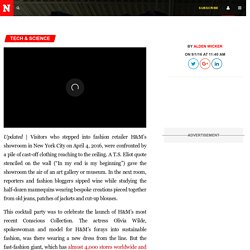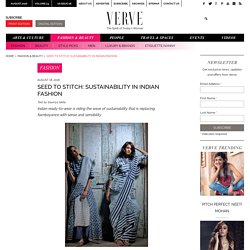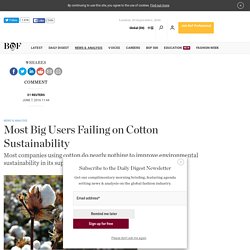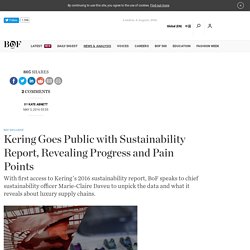

Fast Fashion Is Creating an Environmental Crisis. Updated | Visitors who stepped into fashion retailer H&M’s showroom in New York City on April 4, 2016, were confronted by a pile of cast-off clothing reaching to the ceiling.

A T.S. Eliot quote stenciled on the wall (“In my end is my beginning”) gave the showroom the air of an art gallery or museum. In the next room, reporters and fashion bloggers sipped wine while studying the half-dozen mannequins wearing bespoke creations pieced together from old jeans, patches of jackets and cut-up blouses. This cocktail party was to celebrate the launch of H&M’s most recent Conscious Collection. The actress Olivia Wilde, spokeswoman and model for H&M’s forays into sustainable fashion, was there wearing a new dress from the line. It’s a nice sentiment, but it’s a gross oversimplification. Picture yourself with a trash bag of old clothes you’ve just cleaned out of your closet. If you’re an American, your next step is likely to throw those old clothes in the trash. Made to Not Last Secondhand Africa. Verve Magazine - India's premier luxury lifestyle women's magazine. Fashion Last year, handlooms witnessed a great revival both on and off ramps and became a major talking point in the Indian fashion industry.

The government’s efforts to make Benarasi weaves the fabric of the year contributed to a growing consciousness too. Ecological practices have been steering the fashion industry towards a greener environment. And while one-off initiatives are a boost, there are some designers who are shaking things up at the very core by opting for the sustainable route right at the onset of their careers, tirelessly narrowing the gap between grassroots and glamour. Determined trendsetters Designers Mia Morikawa and Shani Himanshu of 11.11 / eleven eleven — the pret label of CellDSGN Pvt Ltd — have consolidated the roots of their brand in the luxury space with an organic method.
While Morikawa and Himanshu work together to add value to traditions, designer Rina Singh of Eka singlehandedly nurtures her brand by working with handloom clusters around West Bengal. Most Big Users Failing on Cotton Sustainability. STOCKHOLM, Sweden — Most companies using cotton do nearly nothing to improve environmental sustainability in its supply, environmental groups said on Tuesday, citing a report by an online green consumer site.

Traditional farming of cotton, the second-biggest raw material for textile, makes heavy use of pesticides and water. Research by Rank a Brand showed 29 of the estimated 37 biggest cotton users scored red in the survey of policy, sourcing, use and traceability, the report commissioners the World Wildlife Fund, Solidaridad and Pesticide Action network UK said in a joint statement. The world's biggest furniture retailer IKEA was the only company scoring green with 12 of a maximum 19.5 points, followed by apparel retailers H&M and C&A with nine points. The commissioners said around 13 percent of cotton production can be classed as more sustainable, but less than a fifth of it is actually sold as more sustainable. The rest is sold as conventional cotton due to lack of demand. New York Designers Share Their Sustainability Goals at the CFDA + Lexus Panel. Yesterday, the CFDA + Lexus Fashion Initiative hosted an afternoon of presentations and open discussions on sustainability and innovation within the fashion industry.

On hand to share their goals (and take questions from a panel of consultants, activists, and eco-minded business owners) were Tome’s Ramon Martin and Ryan Lobo, Dezso’s Sara Beltran, Prabal Gurung, and Brother Vellies’s Aurora James. Each designer addresses sustainability in a different way for their business, whether it’s socially—i.e., creating jobs in underdeveloped countries—or environmentally, as in cleaner production practices, the use of recycled and reclaimed goods, and the preservation of oceans and forests.
But there were points of similarity, too, which other designers—and editors, buyers, entrepreneurs, and fashion fans—would be wise to consider. Below, see three major ways these designers are working toward a more thoughtful and balanced industry. 1. 2. Kering Goes Public with Sustainability Report, Revealing Progress and Pain Points. LONDON, United Kingdom — Today, French conglomerate Kering will publicly report its performance vis-à-vis sustainability targets voluntarily set in 2012 to reduce the group’s negative environmental and social impact, covering areas including CO2 emissions, hazardous chemicals and the way the company sources gold, leather and precious skins.

The report reveals a mixed picture of progress and pain points. The company has only reached 15 percent of its target to source 100 percent of its gold from verified responsible sources, for example, yet has achieved 99 percent of its target to make its collections PVC-free by 2016. Across its supply chains, the company has also managed to reduce carbon emissions by 11 percent, decrease its waste output by 16 percent and cut its water usage by 19 percent since 2012, falling short of its stated targets to slash all three by 25 percent. Raw materials Kering’s report demonstrates the varying scale of challenges within raw materials. Emissions Social impact.